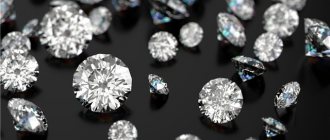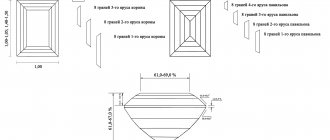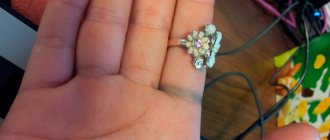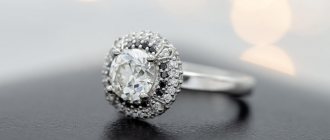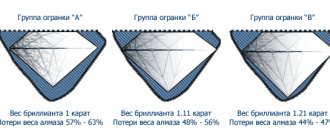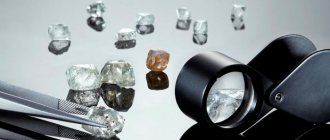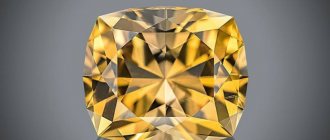How are small diamonds cut?
The stone is clamped into a collet, which in turn is located in a device for cutting diamonds (tang) and is cut on a specially prepared disk. First, the first eight bevels are applied to the stone, bringing them all together at one point, forming a tenon. ... Thus, there are 24 bevels on the bottom of the stone.
Interesting materials:
What does it mean to beat until stiff peaks form? What does Windows 10 Education mean? What does XP on a chain mean? What does xviii mean? What do you mean they fought for it and ran into it? What does spam mean? What does net of income tax mean? What does a blocked call mean? What do tests and exams mean at a university? What does university credit mean?
Precious embryo
At its core, diamond is carbon, just like the graphite in a pencil.
The hardest (not to be confused with the most durable) mineral on the planet. During the formation of our Earth, when magma splashed onto the surface, at high temperature and pressure, graphite turned into crystals, which we know as diamonds. These deposits in which diamonds are found are called kimberlite deposits; they are found on all continents (perhaps Antarctica remains the exception). The proven age of the oldest diamond is over one billion years. In general, their age is hundreds of millions of years. The process of extracting stones is as follows. First, geological exploration is carried out and the locations of possible deposits are determined. Next, soil samples are taken and the diamond content in the rock is determined. If the content of gem-quality diamonds in a deposit exceeds 2 carats (0.4 grams) per ton of rock, then the mining project is considered economically feasible - and the company that has received a license from the government of the country where this deposit was discovered begins mining. A mining and processing plant is being built, where ore begins to flow. Depending on the characteristics of a particular deposit, different beneficiation methods (extracting diamonds from the ground) are used. This is the first stage that affects the cost of the final product. The approximate cost of starting the development of a kimberlite pipe, depending on the complexity, starts at $300 million.
Diamonds are also found in rivers and coastal areas located near kimberlite deposits. You've probably seen films where workers sift soil from the bottom of a river through a large sieve. As the river flows through the kimberlite pipes, it washes away rock and carries it into the open ocean, in which case diamonds can be found along the entire length of the river. The rock settles on an uneven river bottom, from where it is removed by special dredges, on which the ore beneficiation process takes place.
Advertising on Forbes
Story
Remember Princess Diana's famous ring? A huge blue sapphire surrounded by small diamonds - William has already given it to Kate. The Queen of Hearts herself chose this legendary piece of jewelry. Unconventional move? But quite wise. The price of diamonds has not fallen over the last hundred years , but no one dares to predict further. It may well happen that the great-great-grandchildren of the famous couple will again value sapphires or emeralds more.
In the mid-19th century, a large diamond deposit was discovered. The prospectors arrived, there were more and more stones, and then one of the enterprising seekers of fortune came up with a great idea: to rent out equipment for mining stones. In 1883, a certain Cecil Rhodes already controlled a place called Kimberley, and in 1888 his company owned most of the world's production - 90%! As a result, De Beers became a monopoly and were able to dictate diamond prices to the market. And just imagine, the cost of diamonds was far from exorbitant : it was not too different from the prices of semi-precious stones, for example, some topaz or agate could well compete with today’s best friend of girls.
The main factor for the high price was promotion; no money was spared on advertising. And they did the right thing: the price and prestige of diamonds rose tenfold . With the help of cinema, actors and the media, society today perceives diamonds found in the ground as a symbol of luxury and reliability.
But in fact, you shouldn’t expect real benefits from this symbol. According to analysts, it is more profitable for the average person to buy a dress from Christian Dior. Its value, for example, in fifty years can increase tenfold, but the price of a diamond will increase in accordance with the prices of gold, gasoline and food.
A ring with a stone or earrings created in a regular factory, costing up to 500 thousand rubles. will not make it historically important, descendants will be able to either take the ring to a pawnshop (subtract the price for scrap and recycling) or use it for its intended purpose.
Russian princess tiara
One of Queen Elizabeth II's favorite tiaras, the Vladimir Tiara, consists of 15 diamond rings. Mary of Teck, grandmother of the current queen, ordered small jewelry works for her from Garrard & Co.
Initially, the jewelry was ordered for Maria Pavlovna, the wife of Grand Duke Vladimir Alexandrovich, and was complemented with pearl drops. The owner hid her jewelry in the palace during the 1917 revolution, and then she managed, with the help of cunning and friends, to transfer it abroad. The tiara was given to the couple's only daughter . She, in turn, sold it, as she found herself in an extremely difficult situation during her emigration.
Sell in good hands
The next stage is the sale of batches of diamonds directly to jewelry companies, which will set the stone in jewelry and sell it on the retail market. Brokers who have clients all over the world are responsible for this stage. This is the third stage of cost increase. Brokerage firms, like individual brokers, are typically located in large centers called exchanges. There are several such exchanges in the world, the largest are located in Israel and India. There is also a stock exchange in Antwerp, but in terms of size and supply it cannot be compared with the previous ones. As a rule, the exchange is a well-guarded perimeter closed to outsiders, where a complete infrastructure has been created for convenient work. Access here is only possible after a thorough security check. The largest transactions for the sale of large quantities of cut diamonds take place here. It is important to understand that all cutting production facilities are located outside the perimeter, and are often located hundreds of kilometers from the exchange. As an example in India, 95% of stones are cut in Surat, and the exchange itself is located in Mumbai.
From the exchange, the main flow of diamonds, as a rule, ends up in major jewelry centers, such as Hong Kong, Antwerp, New York and Dubai, where the offices of the largest jewelry chains and a huge number of private jewelers are located. The explanation for this is simple: each of these cities is a kind of gateway to one or another region of the world. At this stage, the largest increase in the price of a diamond occurs. If before this the diamond remained on the professional market, where everyone perfectly understands the value and the price increases due to real expenses plus the company’s small earnings, now the price of the stone very much depends on whose hands they fell into, and what the seller is ready to do in order to extract maximum profit. If it is a well-known brand that has large overhead costs, then the price of the stone can often increase three, four or five times. This is facilitated by competent marketers who, in order to increase the cost, create myths about the exclusivity of their jewelry, come up with non-existent parameters and properties of diamonds, new names for standard types of cuts, and many other tricks in order to highlight their product on the market.
Victor J. Blue/Bloomberg via Getty Images
You need to understand: it doesn’t matter who you purchased the diamond from - a private jeweler or a world-famous company. The source of origin of diamonds is the same for both. Only the characteristics specified in the certificate are significant. Deposits located on different continents are distinguished only by the number of high-quality diamonds in the rock, and, accordingly, the average cost of a carat for a particular pipe (Russia, by the way, is far from in first place in this indicator). But whether the stone was mined in Yakutia, South Africa or Australia, if the parameters are the same, does not matter.
How valuable are top quality diamonds?
Diamonds whose color, clarity and cut are at the higher end of the grading scale can be very expensive.
For example, a 1-carat stone that has the best color (grade D), highest clarity (grade IF) and an ideal or excellent cut can cost more than $20,000.
However, a similar stone, but with a carat weight of approximately 0.70-0.75 carats, could cost you approximately $7,000 - $8,000. An even smaller stone of about 0.50 carats can be found for $4,000.
You can find a very decent stone (F color, BBC2 clarity, very good cut) for around $2,000 per 0.50 carat; A diamond of the same quality, but weighing about 1 carat, will cost you in the range of $7,000 - $11,000.
Keep in mind that these prices and ranges can change over time, and a relatively small change in one quality trait can push prices up or down by hundreds of dollars.
African gift
"Cullinan", or otherwise "Great Star of Africa", was discovered in January 1905. It received its name in honor of the owner of the mine. The stone was presented to the English King Edward VII, and Joseph Asker was engaged in cutting. Preparing for the first strike took several months of work. As a result, after the stone was split along a natural crack - it was because of it that it had to be divided - Asker, as the legend says, collapsed.
The largest part was placed in the scepter of Queen Elizabeth II , which is kept on display in the Tower. By the way, you can look at it and personally evaluate the size and shine.
Pearl or diamond
Pearls are a substance formed as a result of the interaction of grains of sand and the mucous membrane of a mollusk. It has a beautiful mother-of-pearl color and will look great on a girl’s neck as a necklace. Pearls are also often used for earrings. Interestingly, pearls, unlike other precious materials, do not need to be processed, so they are sold in their original form. Because of this, its cost is much lower than any other stone, and especially a diamond. However, this does not make it any less beautiful.
How do diamonds differ from each other?
Each diamond used to create a diamond is unique. There is no one generally accepted standard for diamonds in the world, just as there are no two absolutely identical specimens.
Stones of the same color and the same weight can differ significantly in cost, although they will look identical in appearance.
Each diamond is assessed comprehensively according to the 5C classification: Cut, Color, Clarity, Carat and Confidence. The higher all these indicators, the more valuable the gem is.
Carat
The carat or the weight of the stone plays the first violin in determining the final cost of the diamond (1 carat = 0.2 grams). Small stones are evaluated primarily by weight, and only then by other properties.
The value of diamonds is assessed using the “Tavernier rule”: the square of the mass (weight) of the crystal is multiplied by the base price of one carat. Thus, a 3-carat diamond is 10 times more expensive than a one-carat diamond.
The smallest diamonds weigh up to 0.29 carats, medium ones – from 0.3 to 0.99, large ones – 1 carat or more.
Color
When you imagine diamonds, the first ones that come to mind are transparent stones. However, they are not the only existing standard. Many diamonds also have other shades: yellow, brown and even dark blue. The former are the most accessible, but the latter are exceptionally rare.
Colorless pebbles are considered the most expensive. These are crystals of the highest category. Seeing the differences between them is the work of a highly qualified specialist.
Times change along with consumer habits. Today, clear diamonds may seem like a boring classic, so many are increasingly opting for their colored counterparts. They even developed a separate Fancy group for colored diamonds.
Purity
Diamond has been associated with luxury and perfection for centuries, but it itself is not perfect. Yes, yes, almost all diamonds have minor defects and small inclusions! It is difficult to see them with the naked eye - only with the help of a magnifying glass.
Gemologists distinguish the following defects: dots, clouds of small dots, feathers, empty cavities. The latter are the most dangerous and noticeable.
Avoid stones that mention “cavity” in the description: both teeth and diamonds don’t need holes!
The location of inclusions has a direct impact on the cost of the stone. If small imperfections are located on the back/sides, the stone will cost more than one that has them in the center.
As with color, each country has its own standards for grading diamond clarity. In Ukraine, each characteristic of a diamond is expressed in a numerical value. For example, Kr-57-0.15-3/7 on the tag means:
- Kr-57 - cut with 57 facets
- 0.15 - carat weight
- 3 - color (how far from the reference white)
- 7 - inclusions and cracks.
Cut
The most expensive is the round shape K-57 with the brightest play of light. If all proportions are strictly observed, it reflects almost all the light that falls on the stone.
There are other shapes: “emerald”, “heart”, “marquise”, “pear”, “oval”, “princess” (square), etc. The choice of cut does not affect the beauty of the diamond, but does affect its value. A round cut diamond will be approximately 15-20% more expensive.
It is also important to take into account the quality of the cut - correct proportions (Cut), symmetry (Symmetry) and polishing (Polish). All this has a complex effect on the play of light in the stone.
Louis XIV popularized the stone
By the early 17th century, Louis XIV's penchant for diamonds and new types of diamond-embellished jewelry had spread to the general public. Buying jewelry became an integral part of the life of the Parisian nobility in the 17th century.
But ordinary people still did not buy diamonds. Owning diamonds remained an aristocratic extravagance until the late 19th and early 20th centuries. However, by the 18th century, diamonds were so sought after by the elite that King George IV borrowed 12,314 diamonds for his own crown at his coronation ceremony at 15%. Their cost? Sixty-five thousand pounds - more than 10 million US dollars today.
He was unable to pay back this loan, so he was forced to remove the crown and return all the jewelry.
How cheap are low quality stones?
Low quality, i.e. stones with a clarity of I (having inclusions) or lower, a color grade lower than J, and a cut of mediocre or lower can be found for less than $1,000 to $2,000 (for stones weighing 1 carat or less).
You can find some fairly large stones in this quality range that are quite cheap, but these diamonds are unlikely to be worth the money.
Poor quality stones will usually appear stained and have visible flaws, and their brightness will be very low due to poor cutting.
How to make big money in World War II
But the worst crime may be war profiteering. When America entered World War II, there was little reason for people to buy diamonds: most of the money went to American-made goods to help the war effort. Do you know what helps the military the most, according to advertisers? Buying diamonds from De Beers. To make matters worse, De Beers did not need to produce diamonds during this time, since by then virtually all the useful diamonds that could be shipped overseas had been mined.
Diamonds have been highly prized throughout most of history.
In 77 AD, Pliny the Elder wrote about adamas, a mineral of extreme value that was for a long time only available to kings. "Adamas" in Latin means "invulnerable", and it is thanks to this word that we get the modern name "diamond".
However, diamonds were known to people long before the works of Pliny. They were among the first gemstones to appear in India in the 4th century BC. For centuries, diamonds were believed to be found only in India, which is why they were called an extremely rare mineral. And this supposed rarity made diamonds a real treasure.
Differences between moissanite and diamond
Let's consider another analogue of the “king of stones”, moissanite. It is silicon carbide and has the formula SiC.
Natural moissanite was first discovered at the end of the last century in Arizona. Its discoverer was the French chemist Ferdinand Moissan, who christened the new mineral with his own name.
As it turns out, there is very little natural moissanite on Earth: it is found mainly in the remains of meteorites. As a rule, there are small pebbles that do not have a diamond shine and transparency. The largest nuggets found did not exceed a few millimeters in diameter.
Almost at the same time, Edward Atcherson patented a technology for the synthesis of powdered SiC, which was used primarily in the production of abrasives. It was a synthetic carborundum material, chemically a complete analogue of moissanite.
The invention of the technology for synthesizing jewelry-quality carborundum produced a real revolution. Jewelers received an almost complete analogue of a diamond, which is more than an order of magnitude cheaper than its noble counterpart. However, even synthetic moissanite is much more expensive than cubic zirconia.
Natural moissanite is negligible. So don’t trust sellers: you won’t find jewelry with this naturally occurring mineral. But carborundum is a permanent resident of jewelry store shelves.
It is almost impossible to distinguish moissanite from a diamond at home, at least not for a specialist. All methods that can be applied without the use of special equipment lead to damage to moissanite or require the presence of a natural diamond as a sample.
You can recognize a diamond next to a moissanite by its more subdued shine: the second shines brighter due to its higher refractive index. Moissanite is equally transparent, very refractory, and resistant to aggressive chemicals. Its hardness ranges around 9 on the Mohs scale. This means that it can be scratched with a diamond, but not with anything else.
Gold earrings with diamonds (go to the SUNLIGHT catalogue)
If you don't mind the stone, you can perform a basic thermal test. Apply the flame of a match or lighter to the diamond and moissanite. Both stones will become smoky, but if the diamond appears in its original form after cleaning the carbon deposits, the carborundum will turn green and become cloudy.
Diamonds were only available to kings
In the 13th century, Louis IX of France loved diamonds so much that heavy, diamond-encrusted outfits were created especially for him. Louis IX decided that only members of the royal family could wear these stones. He even went so far as to create a special law prohibiting anyone from wearing diamonds, in case rich people could afford it.
What does the price consist of?
The price of a diamond is influenced by four parameters that formed the basis of the universal 4C grading system proposed by the Gemological Institute of America (GIA) in the 40s of the 20th century:
· carat weight;
· color (color);
· purity (clarity);
· cut.
Colorless or almost colorless diamonds of medium and large size, which have virtually no defects visible at tenfold magnification, and have a round Kr-57 cut, are expensive. Then why are colored gemstones also expensive? Diamonds of yellow, pink, light blue, indigo, green, orange, and lilac colors are called fancy and are considered rare, which also leads to an increase in cost - $1 million per carat is not uncommon.
Single-piece colored stones - only 2-3 colored diamonds can be found per year. Blacks are not considered fantasy. And the most valuable of this group are blue and red diamonds.
Single finds of red diamonds weighing 0.1 carats or more are considered world exclusive. They were found exclusively in a mine in Australia; in the entire history, less than 20 red specimens were discovered.
How to choose the optimal diamond based on the price = quality principle?
The average buyer is unlikely to notice the difference between two colorless diamonds in a ring. In small products, errors in cleanliness are even less visible. Therefore, when buying a diamond without a setting, it is easier to make sure that minor defects will not be hidden from you.
Jewelers advise first deciding on the size and color of the diamond, and then experimenting with clarity. For example, you can save money by choosing a stone with a yellowish color, but with a larger size and higher purity - then it will sparkle like a drop of crystal clear water.
Heading for Hollywood
To return diamonds to their popularity, NW Ayer has set its sights on the new royal family: Hollywood. Advertisers tried to squeeze diamonds into movie scripts and adorned actresses with them.
Smooth and fresh skin: dermaplaning, or why a woman needs to shave her face
A Brazilian travels 36 km by bike every day to take his loved one home.
A student at the Vietnam Police Academy shared how she takes care of her facial skin.
The advertising agency also attacked the print market. By 1940, Brides magazine, Reader's Digest and the New York Evening News carried more than 20,000 diamond news and stories.
About Tiffany
The film "Breakfast at Tiffany's", of course, was paid for by advertisers. Its resounding success made the diamond the leading stone in sales for a long time.
The main character, Holly Golightly, praised the boutique, explaining that only there she felt calm and protected: “Suddenly you become upset, and you don’t know what’s upsetting you.<…> The only good thing at such a moment is to jump into a taxi and go to Tiffany's. Nothing really bad will happen while you're there." (Translation by the author from English according to the script).
The first store was opened in September 1837 by Charles Lewis Tiffany and John Young. Both names were in the title. It all started with small and inexpensive goods: souvenirs, pens, other stationery.
But they chose their main color even then, it was simply popular at that time - the color of robin eggs (robin egg blue).
About the cut
So, back to fashion. We open magazines and find that almost all jewelry on models, actresses and in advertising is silver in color. It is most likely white gold: its color is achieved through the use of impurities such as platinum. Yellow gold is much less common today. It is generally accepted that it is not suitable for wearing every day.
Pink is also not the most popular option, since it contains copper. Nevertheless, it is customary to produce collections for the mass market using these three alloys.
You might be interested in: fashionable wardrobe for spring and summer - what to look for, how to save money, what to look for in your closet?
From diamond to diamonds
After the diamond is recovered, the mining company sells it through an auction or through direct contracts to large cutting plants. The largest auctions for the sale of rough diamonds take place in Antwerp and Johannesburg, from where diamonds are bought by companies located mainly in Israel and India. After careful examination of the crystal by gemologists and cutters, identifying all the weak points (if processed incorrectly, the diamond can explode), a decision is made on what shape the diamond will be. Usually the decision is made based on the maximum value that can be extracted from the sale of the resulting diamond. Maximum cut quality characteristics fade into the background. A poorly cut five-carat diamond will always cost more than a perfect three-carat diamond. But it was not always so. In the cutting industry of the USSR it was believed that the main thing was the quality of the cut. Often losing up to 75-80% of the diamond mass during processing. As a result, the cost of a cut diamond was often lower than the cost of a diamond before cutting. After cutting, diamonds are carefully sorted into lots; good quality stones over 0.3 carats are sent for certification to gemological laboratories. Certification is a different story, here I just want to mention that parameters such as color and purity of the stone are determined by an expert by eye. There is still no accurate equipment that can determine these parameters of a diamond with 100% probability.
Alexander Ryumin/TASS
Gift to Catherine II
It is impossible not to mention the stone that Count Orlov presented to our empress. A truly royal gift. There is simply no larger stone in the Russian Diamond Fund. Perhaps, based on this historical fact, Russian girls love to receive jewelry as a gift from their beloved men?
The size of the stone is impressive: 22 mm/31-32 mm/35 mm, weight - 199.6 carats. This diamond also has its own color – greenish-blue.
But could the count really give such an expensive gift? Unfortunately, some historians saw fiction in this beautiful story. Perhaps Catherine herself gave Orlov money from the treasury for this purchase , thus deceiving the people. The fact is that she loved jewelry very much and was clearly expecting a stone.
It was immediately ordered to be inserted into her scepter, and documents about fittings of a similar size only confirm this fact.
Editorial opinion
Ilya Tarasov
Chief Editor
Ask a question to the author
Dear readers, leave comments under the article, share it on social networks, and if you have questions for the author, be sure to ask. Feedback is important to us.
What is more valuable than a diamond?
But still, a potential buyer may have a question: which stone will be more expensive than a processed diamond? As mentioned above, pricing can be affected by the color, cut, clarity and weight of the stone. Therefore, there are several factors to consider when answering this question. However, with approximately the same quality, the following minerals can be distinguished, which may be more expensive than diamond gems:
- Emerald weighing over five carats. The ideal emerald is rarely found in such a large size that it can later be used to make a jewel weighing more than five carats. The cost per carat of such a mineral can be over one hundred thousand dollars.
- Alexandrite. This is a very rare gem that is not easy to obtain. The richest deposits in alexandrite are located in the Urals. Such a stone costs from forty thousand green for one carat. The larger the size, the more expensive one carat of this crystal will be. Most often it is used for inlaying rings. The oval cut allows you to achieve the effect of visually lengthening the finger, which is why the jewel is especially popular among the fair sex.
- Ruby. The average price for a high-quality mineral is fifteen thousand dollars, and especially saturated and beautifully cut ones are expensive - up to one hundred and fifty thousand dollars. But large expensive stones are mainly purchased by museums or wealthy collectors.
Interesting facts about stones
The most valuable diamonds have color, but they are much less common in nature than clear diamonds. The most desirable diamond is red. Incredible luck for the miners and a fortune, according to appraisers.
The average price of a good quality round diamond with a diameter of up to seven millimeters is 500 thousand rubles.
If there is a certificate, even large stones can be transported across the border without restrictions.
Even in ancient Rome, diamonds were measured in carats. A carat is a seed of Ceratonia pod, which has a constant weight.
In Russia, buying real diamonds is not the easiest task. Both Chinese fakes and Thai low-quality analogues are sold on the market today.
When purchasing, you need to carefully study the tags, request a certificate, it’s even better to search for the factory through a search engine.
You cannot take stones with incomprehensible abbreviations in the passport. And if the purchase is made in Russia, look for a ring or earrings made by us.
South African diamonds changed everything
Until the 19th century, India blocked the diamond trade. Nobody knew that they could be looked for elsewhere. Then, in 1866, a 15-year-old boy picked up a 22-carat diamond from the Orange River near Hopetown, South Africa.
“We are still friends”: Derevianko commented on the breakup with his wife
If there is little snow, there will be no harvest: December 16 is Ivan the Silent Day
It’s good to wash often: myths about shampoo and hair care that only harm
In 1861, an English explorer discovered massive diamond mines in Kimberley, the capital of the Northern Cape. This changed the history of their mining.
From mine to cutting: why are diamonds so sought after?
The answer lies on the surface: due to its properties - very unique. But not only. A successful marketing campaign also played the lion's share in this.
The exceptional hardness of a diamond is its uncompetitive advantage. Highest score on the Mohs scale! A diamond can be burned or broken, but not scratched. In the absence of mechanical stress and ultra-high temperatures, a diamond retains its original appearance for hundreds of years. The stone is also capable of reflecting and refracting light rays, creating glare of all colors of the rainbow.
Worldwide popularity, which secured absolute primacy, came to the diamond in the mid-19th century. De Beers' brilliant "Diamonds Are Forever" marketing campaign played an important role in this. Since that time, the stone has been perceived as a unique symbol of love, and a diamond engagement ring has become a must-have gift for a bride on her engagement day.

